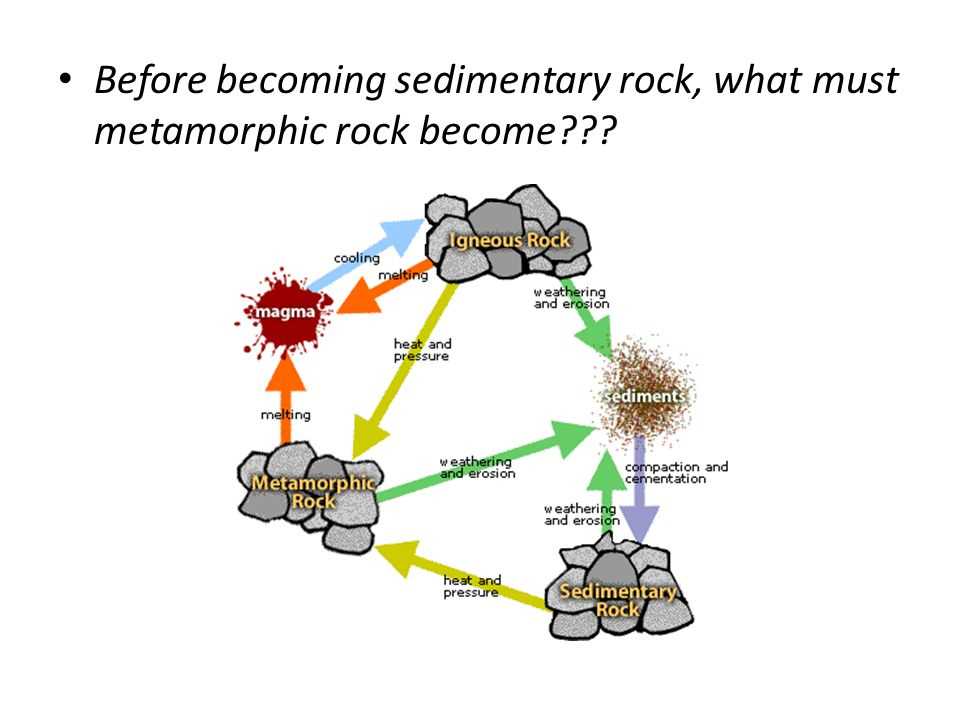
Embarking on a journey deep into the geological wonders of the Earth, the Rock Cycle Webquest is a fascinating quest for knowledge. As you delve into the world of rocks and minerals, a myriad of questions arise, waiting to be answered. Let’s uncover the answers together and unlock the secrets behind the beautiful tapestry of rocks and minerals that make up our planet.
With each step of the Rock Cycle Webquest, the intricate dance between heat and pressure, weathering and erosion, and deposition and lithification comes to life. Discover how the three main types of rocks – igneous, sedimentary, and metamorphic – undergo transformation, constantly shifting and evolving over millions of years.
As you navigate through the webquest, you’ll encounter thought-provoking questions about the processes that shape the Earth’s surface and the forces that mold rocks and minerals. From the mighty volcanoes that spew forth molten rock to the serene shimmer of sediment settling at the bottom of a lake, each component of the rock cycle offers a glimpse into the Earth’s geological history.
What is the rock cycle?
The rock cycle is a natural process that describes how rocks are formed, broken down, and transformed over time. It is a continuous cycle that involves the interaction of different Earth processes, including erosion, heat, pressure, and melting. The rock cycle consists of three main types of rocks: igneous, sedimentary, and metamorphic.
First, igneous rocks form when magma (molten rock) cools and solidifies either on the Earth’s surface or underground. This can happen through volcanic activity or the solidification of magma chambers. Examples of igneous rocks include granite, basalt, and obsidian.
Next, sedimentary rocks are formed when sediment, such as sand, mud, or shells, accumulate and become compacted over time. This process is called lithification. Sedimentary rocks often contain fossils and can be found in layers. Common examples of sedimentary rocks include limestone, sandstone, and shale.
Finally, metamorphic rocks are formed when existing rocks undergo intense heat and pressure deep within the Earth’s crust. This causes the minerals within the rock to recrystallize, giving the rock a new texture and often a new mineral composition. Examples of metamorphic rocks include marble, slate, and gneiss.
The rock cycle shows how these three types of rocks can be transformed into one another over time. For example, igneous rocks can be weathered and eroded to form sediment, which can then become compacted and lithified to form sedimentary rocks. These sedimentary rocks can then be subjected to heat and pressure to become metamorphic rocks. And in turn, metamorphic rocks can melt to form magma and start the cycle all over again.
The rock cycle is an important concept in geology as it helps scientists understand the processes that have shaped and continue to shape the Earth’s surface. It also provides insights into how different types of rocks and minerals are formed, which can be useful for a variety of applications, from natural resource exploration to understanding Earth’s history.
Why is understanding the rock cycle important?
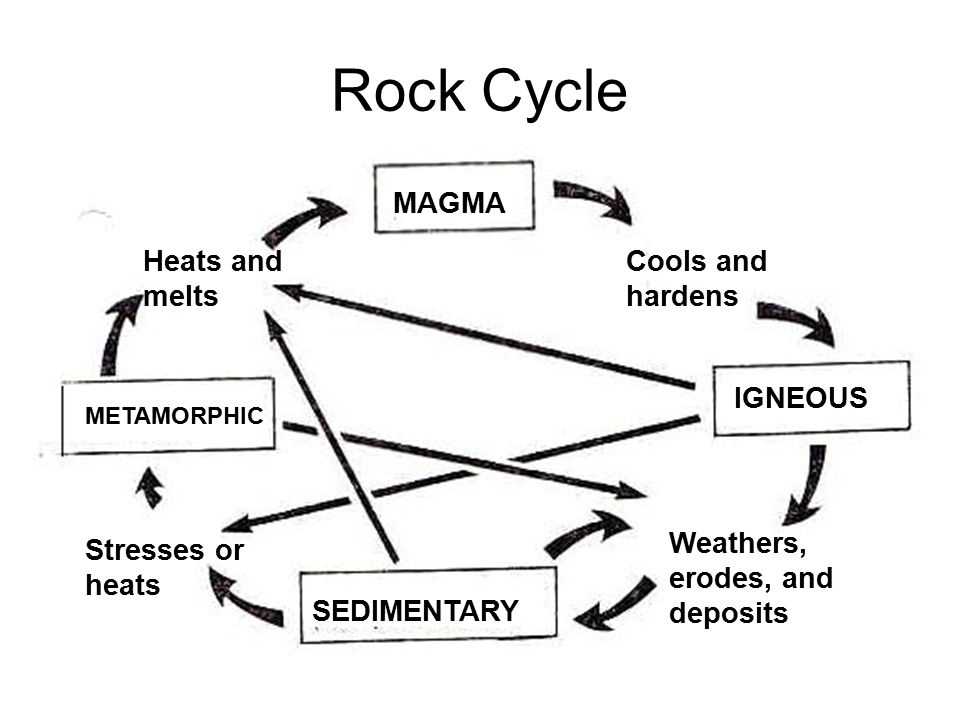
The rock cycle is an essential concept in the study of geology because it helps us understand the dynamic processes that shape the Earth’s surface. By understanding the rock cycle, scientists and geologists are able to analyze and interpret the different types of rocks found on Earth, as well as the processes that have occurred over millions of years to form these rocks.
One of the key reasons why understanding the rock cycle is important is because it provides insights into the history of the Earth. Rocks contain valuable information about past geological events, such as volcanic eruptions, tectonic plate movements, and climate changes. By studying the different types of rocks and their characteristics, scientists can reconstruct the geological history of an area and gain a better understanding of how our planet has evolved over time.
Additionally, understanding the rock cycle is important for practical applications, such as the exploration and extraction of mineral resources. Different types of rocks contain valuable minerals, metals, and fossil fuels that are essential for various industries. By understanding the rock cycle, geologists can identify the locations where these resources are likely to be found and develop strategies for their extraction in an efficient and sustainable manner.
In conclusion, understanding the rock cycle is crucial for gaining insights into the Earth’s history, as well as for practical applications such as resource exploration. By studying the rock cycle, scientists and geologists can decipher the complex processes that have shaped our planet and utilize this knowledge for various purposes.
Types of rocks
There are three main types of rocks: igneous, sedimentary, and metamorphic rocks. Each type of rock has unique characteristics and is formed through different geologic processes.
Igneous rocks
Igneous rocks are formed from the cooling and solidification of molten rock, also known as magma or lava. They can be further classified into intrusive and extrusive igneous rocks. Intrusive igneous rocks form when magma cools slowly beneath the Earth’s surface, resulting in coarse-grained textures. Examples of intrusive igneous rocks include granite and gabbro. On the other hand, extrusive igneous rocks form when lava erupts onto the Earth’s surface and cools quickly, resulting in fine-grained or glassy textures. Examples of extrusive igneous rocks include basalt and obsidian.
Sedimentary rocks
Sedimentary rocks are formed from the accumulation and compaction of sediment particles. This process occurs over millions of years and results in the formation of layered rocks. Sedimentary rocks can be further classified into three types: clastic, organic, and chemical sedimentary rocks. Clastic sedimentary rocks are composed of rock fragments and minerals, such as sandstone and shale. Organic sedimentary rocks are derived from the remains of once-living organisms, such as limestone and coal. Chemical sedimentary rocks form when dissolved minerals precipitate out of water, such as halite and gypsum.
Metamorphic rocks
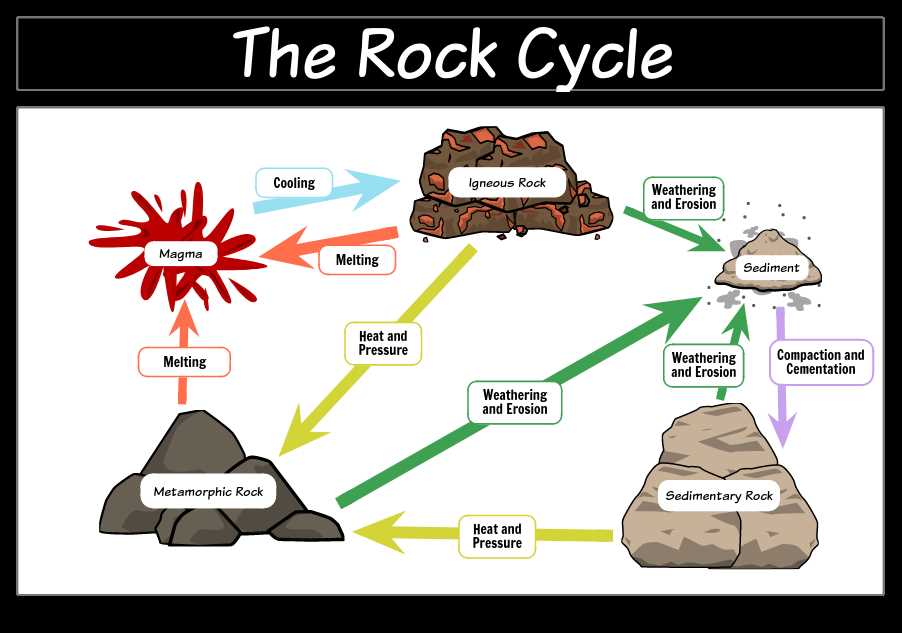
Metamorphic rocks are formed through the transformation of existing rocks due to high temperatures and pressures. This process leads to changes in the mineralogy, texture, and structure of the rocks. Metamorphic rocks can be further classified into foliated and non-foliated rocks. Foliated metamorphic rocks have a banded or layered appearance, resulting from the alignment of minerals. Examples include slate and gneiss. Non-foliated metamorphic rocks lack a layered appearance and have a more uniform texture, such as marble and quartzite.
In summary, the rock cycle involves the formation, transformation, and recycling of these three main types of rocks: igneous, sedimentary, and metamorphic rocks. Understanding the characteristics and processes of each rock type is crucial in unraveling the Earth’s geological history and the dynamic nature of our planet.
How are igneous rocks formed?
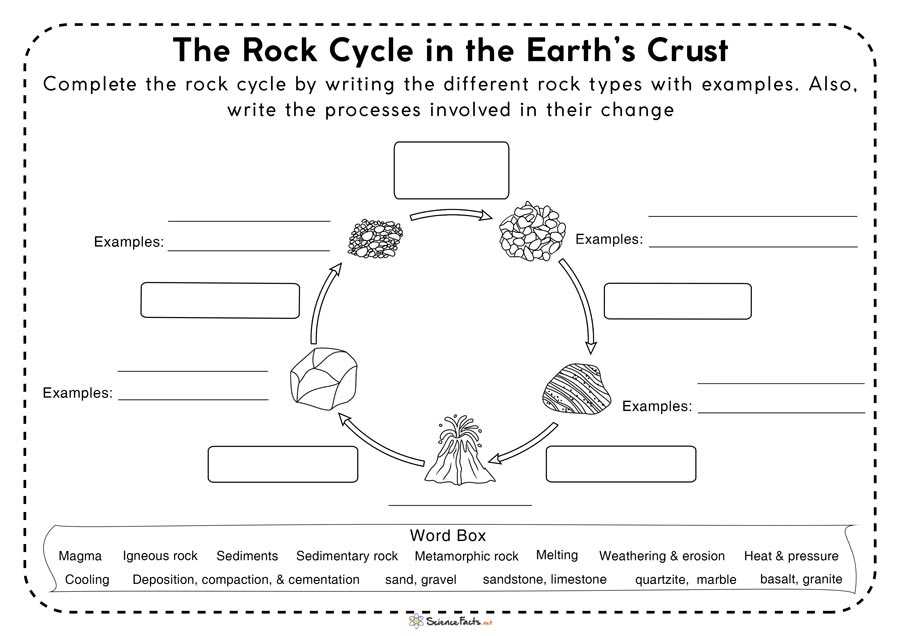
Igneous rocks are formed when molten lava or magma cools and solidifies. This process is known as solidification or crystallization. The formation of igneous rocks typically occurs within the Earth’s crust or on its surface during volcanic eruptions.
When magma rises to the surface through volcanic activity, it is exposed to cooler temperatures, causing it to cool and solidify rapidly. This rapid cooling results in the formation of fine-grained igneous rocks, such as basalt. On the other hand, when magma cools slowly beneath the Earth’s surface, such as in an intrusive igneous rock formation, large crystals have time to grow, resulting in the formation of coarse-grained igneous rocks, such as granite.
The composition of the magma or lava also plays a significant role in the formation of igneous rocks. Magma is predominantly made up of silicate minerals, such as quartz, feldspar, and mica, along with various other minerals and gases. The specific combination and proportion of these minerals determine the characteristics and properties of the resulting igneous rock.
Overall, the process of igneous rock formation involves the cooling and solidification of molten lava or magma, which can occur both on the Earth’s surface and within its crust. The cooling rate and composition of the magma determine the texture and mineral composition of the resulting igneous rock.
What Are Sedimentary Rocks?
Sedimentary rocks are a type of rock that forms from the accumulation and hardening of sediment. Sediment is made up of small particles of rock, soil, and organic material that are carried by water, wind, or ice and deposited in layers. Over time, these layers become compacted and cemented together to form sedimentary rocks.
Sedimentary rocks are classified into three main types: clastic, chemical, and organic. Clastic sedimentary rocks are made up of fragments of other rocks that have been weathered and transported by water, wind, or ice. These fragments, called clasts, are usually sorted by size and shape. Chemical sedimentary rocks form when minerals dissolve in water and then precipitate out of the solution. Organic sedimentary rocks are made up of the remains of plants or animals that have been compacted and preserved.
- Clastic sedimentary rocks examples include sandstone, shale, and conglomerate.
- Chemical sedimentary rocks examples include limestone, gypsum, and rock salt.
- Organic sedimentary rocks examples include coal and limestone.
Sedimentary rocks often contain fossils, which are the preserved remains or traces of ancient plants and animals. Fossils provide important clues about Earth’s history, including changes in climate and the evolution of life forms. Sedimentary rocks also play a key role in the rock cycle, as they can be weathered and eroded to form sediment, which can then be compacted and cemented to form new sedimentary rocks.
What are metamorphic rocks?
Metamorphic rocks are one of the three main types of rocks found on Earth, along with igneous and sedimentary rocks. They are formed through a process called metamorphism, which involves intense heat and pressure deep within the Earth’s crust.
Metamorphic rocks start out as either igneous or sedimentary rocks, but they undergo a physical or chemical change due to the high temperatures and pressures they are exposed to. These changes cause the minerals in the rocks to rearrange and recrystallize, resulting in a new rock with different characteristics. The original rock’s texture, mineral composition, and fossil content are altered during this process.
Metamorphic rocks can have a wide variety of textures and colors, depending on the amount of heat and pressure they were subjected to. Some common examples of metamorphic rocks include marble, which is formed from limestone, and slate, which is formed from shale. Other types of metamorphic rocks include quartzite, gneiss, and schist.
Metamorphic rocks are often found in mountain ranges and areas with high tectonic activity, as these are the places where intense heat and pressure are most likely to occur. They play an important role in the rock cycle by transforming one type of rock into another. Metamorphic rocks can also provide valuable information about the geological history of an area, as their formation is influenced by the conditions that existed at the time of metamorphism.
Processes in the rock cycle
The rock cycle is a continuous process that involves the formation, transformation, and recycling of rocks on Earth’s surface. It is driven by various geologic processes, including weathering, erosion, deposition, compaction, and cementation.
Weathering is the initial step in the rock cycle, where rocks are broken down into smaller fragments through mechanical, chemical, and biological processes. Mechanical weathering involves physical forces that break rocks into smaller pieces, such as wind, water, and ice. Chemical weathering occurs when rocks are chemically altered or dissolved through reactions with water, gases, or living organisms.
Erosion is the process by which weathered materials, such as rock fragments and soil, are transported and removed from their original location. It is typically caused by natural agents, such as wind, water, or ice, and can occur gradually or rapidly depending on the intensity of the erosional forces.
Deposition is the opposite of erosion, where transported materials are deposited or settled in new locations. This can happen through the action of gravity, water currents, or wind. Deposition is responsible for forming sedimentary rocks, which are composed of accumulated sediments.
Compaction is the process by which sediments are compressed and squeezed together due to the weight of overlying layers. This compression reduces the pore space between sediments and causes them to become more tightly packed. As a result, the sediments undergo physical and chemical changes that transform them into sedimentary rocks.
Cementation is the final step in the formation of sedimentary rocks, where minerals precipitate and fill in the gaps between sediment grains. This process occurs when dissolved minerals in groundwater are deposited and bind the sediments together, creating a solid rock mass.
The rock cycle is a dynamic and interconnected system, where rocks continuously undergo changes and transform from one type to another. Through these processes, rocks can be weathered, eroded, transported, deposited, compacted, and cemented, allowing for the formation of various rock types and the recycling of Earth’s materials.
Erosion and Weathering
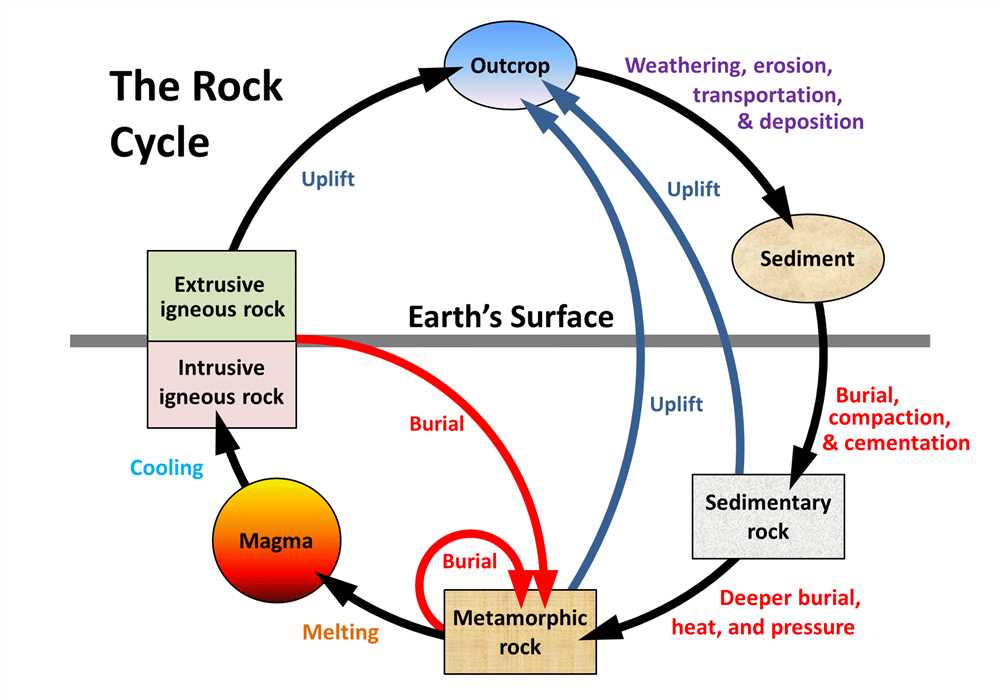
Erosion and weathering are two vital processes that contribute to the shaping of the Earth’s surface over time. These processes are responsible for breaking down rocks and transporting sediments to create new landscapes.
Weathering refers to the natural process of breaking down rocks and minerals into smaller fragments through physical, chemical, and biological means. This process occurs due to exposure to various environmental factors such as temperature changes, water, wind, and even living organisms. Physical weathering, for example, occurs when rocks are broken apart by freeze-thaw cycles or the expansion and contraction caused by heating and cooling. Chemical weathering involves the breakdown of rocks through chemical reactions, such as oxidation or dissolution. Biological weathering occurs when living organisms, like plants and bacteria, contribute to rock decay through their growth or by secreting chemicals that dissolve minerals.
Erosion, on the other hand, is the process by which weathered material is transported and removed from one location to another. It is primarily driven by the movement of water, wind, ice, or gravity. Water erosion occurs when flowing water carries away sediments from rivers, streams, or even rainwater runoff. Wind erosion, on the other hand, picks up and transports loose particles of sand, dust, or soil. Glaciers erode and transport large amounts of rocks and sediments through the processes of plucking and abrasion. Gravity can also cause erosion through mass movement, such as landslides and rockfalls.
The combined effects of weathering and erosion are responsible for shaping the Earth’s surface features, including mountains, valleys, canyons, and coastal cliffs. By continually breaking down rocks and moving sediment, these processes play a critical role in the rock cycle, contributing to the formation of new rocks and minerals.